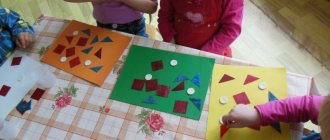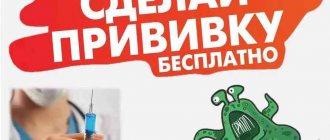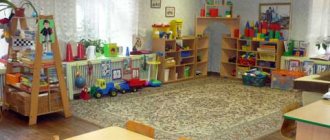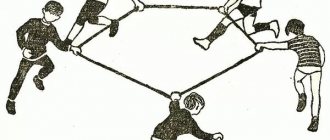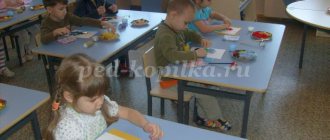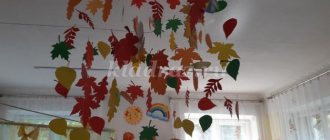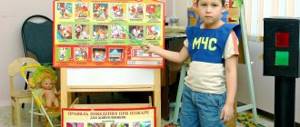Comprehensively - thematic planning in the middle group. Clothes, shoes, hats
Comprehensive thematic planning on the topic “Clothes, shoes, hats.”
Planning for one day in the middle group of kindergarten
Author: Kolesnikova Svetlana Aleksandrovna. Position: Educator. MKOU Berezovskaya secondary school is a structural subdivision of MKOU Berezovsky kindergarten ORV village. Berezovka, Anninsky district, Voronezh region. Purpose: The material is intended for middle group kindergarten teachers. Can be used for daily planning of work in kindergarten. Goal: Dissemination of work experience to enrich the methodological knowledge of educators.
Monday January 19, 2020.
Topic of the day: “Clothes, shoes, hats.” Purpose: Familiarization with the names of items of outerwear, shoes, hats; formation of children's cognitive interest in items of clothing. Tasks :1. Introduce children to the history of the origin of things. 2. Teach to distinguish things by seasonality, place of use, accessory.. 3. Teach how to care for your own wardrobe items and shoes. The priority types of children's activities are cognitive development. 1 half day. Morning.
Reception of children.
Conversation about the weather. Filling out the weather calendar. Appointment of duty officer. Gymnastics. 1. Formation in a line. — Turns on the spot; — Walking is normal; - Walking backwards; Alternating with normal walking - Walking on toes; - Walking on heels; — Running at different paces — Forming a column of three, breaking up. 2. “Let’s warm ourselves up” - 10 times. I.P. - legs apart, arms to the sides / exhale / 1. wrap your arms around yourself / exhale /; 2. I.P. pace is average. 3. Let's dance 4 times with each leg. I.P. - legs together, hands on the waist 1. put your right leg forward; 2. raise the leg bent at the knee; 3. put your right foot forward; 4. I.P. Do not hold your breath, the pace is average. 4. “Hide our hands” 5 times in each direction. I.P. - legs apart, arms to the sides. 1. turn to the left, hands behind your back; 2. I.P. /inhale/ Medium tempo. 5. Raise your hands - 8 times. I.P. - legs together, hands on the waist. 1. hands to shoulders; 2. hands up /inhale/; 3. hands to shoulders; 4. I.P. The pace is average. 6. "Springs". - 8 times. I.P. - legs apart, hands on the waist. 1. half squat; 2. half squat; 3. sit down deeply; 4. I.P. pace is average. 7. Let's take out the socks. I.P. - legs apart, arms up; 1. bend forward, touch the floor with your hands /exhale/; 2. I.P. The pace is average. 8. Running around the building; 9. Walking Organized care. Breakfast. Conversation-reminder “Rules of behavior at the table.” Direct educational activities. Conversation about clothes. The history of the appearance of the first clothes (Adam and Eve). The history of the development of clothing (what clothes were made from in the past and what they are made from now). Familiarization with types of fabric (children look at samples of different fabrics: calico, corduroy, leather, silk, denim, drape, wool and figure out what clothes can be made from this material). Assignment: Dress made of chintz - (what?) - (chintz). Denim skirt - (what kind?) – denim. Silk blouse - (what?) - (silk). Corduroy trousers – (what?) – (corduroy). Leather jacket – (what?) – leather. Skirt made of wool - (what?) - wool. Fur jacket – (what?) – fur. T-shirt made of cotton fabric – (what?) – (cotton). Looking at different clothes in the picture. Children repeat after the teacher the names of parts of clothing (pocket, cuffs, collar, zipper, frills, belt). Assignment: Look at pictures with missing parts of clothing and determine which parts are missing. Consolidating knowledge of the names of shoes, their purpose and components. Children look at pictures of shoes, name them and explain why this or that shoe is needed (walking in the rain, in cold or hot weather, walking at home, playing sports). Together with the teacher, children name the components of the shoe: heel, toe, heel, shaft, sole, fastener, zipper, laces, Velcro. Familiarization with the variety of materials for shoes (leather, rubber, corduroy). Assignment: Boots made of leather – (what?) – leather. Rubber boots - (what?) - rubber. Familiarization with the name and purpose of hats. The teacher shows pictures of hats and names them (beret, hat, panama hat, scarf, scarf, hat, cap). Children examine and explain their purpose. Assignment: Straw hat – (what?) – straw. Felt cap – (what?) – felt. Game “Say the other way around” (example: dad has big shoes, but his son has small ones). Exercise to develop attention: find monkeys in identical dresses in the picture. Physical education minute. Together we help mom: Get up, bend over.
We rinse the laundry ourselves.
Move your hands left and right.
One, two, three, four -
They stretch and wipe the “sweat” from their forehead with their hand.
Stretched, bent,
tilted.
Well done!
They wipe their hands.
Drawing patterns on gloves.
Children place their hand on a piece of paper and trace the brush with a colored pencil or felt-tip pen. Children draw a picture - a snowflake, decorate the upper and lower parts of the glove with a pattern. Reflection (What did we do today? What did you like most?). 2 breakfast. Conversation “Why do we need napkins on the table?” Walk. Observation “How are passers-by dressed?” Draw children's attention to how passers-by are dressed. Remember how they were dressed in the summer. Outdoor games.
"Living Labyrinth"
"Don't get your feet wet." Dinner. Conversation “Rules of table setting.” Daytime sleep. Learn to undress and dress consistently, and carefully fold clothes on a high chair. 2 half day. Reading the fairy tale “The Living Hat.” Looking at pictures of national costumes. Competition "Who can paint the princess's dress better." Free play activity. Children going home. Interaction with parents: Consultation for parents “Child’s clothing in a group.”
We recommend watching:
Long-term planning for music education in kindergarten. First junior group Long-term planning for music education in kindergarten. Second junior group Comprehensive - thematic planning of the educational process in a preschool educational institution Individual development program for a child with severe speech impairments
Similar articles:
Comprehensive thematic planning for cognitive and speech development in the senior group
Comprehensive thematic planning for artistic and aesthetic development in the senior group
Planning a thematic week in the first junior group in September
Planning educational work for the week in the first junior group “Furniture. My house"
Zarkua Alena
Planning educational work for the week in the first junior group “Furniture. My house"
PLANNING EDUCATIONAL WORK (for the week from 11/07/2017 to 11/10/2017)
Topic: Furniture . My house"
Final event: Puppet theater “ Furniture of the Three Bears ”
.Date of the final event: Friday 11/10/2017
Responsible for the final event: Zarkua A.V.
Day of the week
Mode
Integration of educational areas Joint activities of adults and children, taking into account the integration of educational areas Organization of a developmental environment for children’s independent activities (activity centers, all group )
Interaction with parents/social partners
Group,
subgroup
Individual educational activities in special moments
1 2 3 4 5 6 7 8
Tuesday – November 7
Morning: Phys. development
Having known it once
Social commun. development
Speech development Admission of children. Morning exercises.
Conversation “ Furniture in our home ”
— enrich children's knowledge about
furniture .
Develop speech, the ability to speak in complete sentences. Finger game “Lots of
furniture in the apartment ” (Finger gymnastics file)
.
D/i “Politeness”
with Yana.
Goal: creating conditions for developing the skill of saying hello when entering a group . Consideration of topics. pictures, poster " Furniture "
.
Tour of the group . Purpose: to determine what furniture is in the group . Consolidating knowledge about furniture and its purpose.
Display in the book corner
topics pictures, poster.
Create a game situation for children’s cognitive activity by preparing: d/i.
Independent activity of children. Ind. conversations with parents about the well-being of children
Ask to bring clippings and illustrations to supplement the contents of furniture
Direct educational activities Learning times
Phys. times
1. FEMP: Topic: Lesson 1. (I. A. Pomoraeva, V. A. Pozina FEMP junior group p . 16)
Goal: to learn to compare two objects in length and denote the result of comparison with the words long - short, longer - shorter; improve the ability to compose a group of objects from individual objects and isolate one object from a group , denote aggregates with the words one, many, none.
2. Physical education lesson. Lesson No. 1 P. n. d. p. 373. – practice standing long jump, throwing into the distance with the right and left hand; learn to step over obstacles; consolidate the ability to respond to a signal, act on a signal.
Walk: Cognition
Phys. development
Social and communal development
Speech development
Hood-esthete walk 3. Observation of the clouds. (K.P. nsportal.ru›…kartoteka-progulok-v-mladshey-gruppe) – form concepts about clouds and clouds.
P/n “Run to me”
- learn to navigate by sound, move towards the sound. Practice walking in a straight direction through game tasks.
D\I “Name the furniture ”
Arina, Dasha, Kira. A situational conversation about how you shouldn’t run around while walking, you need to play together and in a friendly manner, walk carefully, looking at your feet. Organize independent play activities for children with external materials.
Cultivate the desire to play together, together, giving up toys to each other.
work before bed Remind about the benefits of daytime sleep: “We walked, we played, and we were a little tired, in order to gain more strength, we need to get a little sleep. KGN.
Evening:
Health-improving gymnastics after sleep. Walking on a massage mat.
Conversation furniture for ?”
.
Discussion. Reading the fairy tale “The Three Bears”
- teach emotionally, be attentive to
figurative words ; help to assimilate the content of the fairy tale through modeling. Flamingo
Publishing House , 2009, p. 31) D/i
“What has changed”
- the development of attention and observation.
Roma, Polina, Anna.
Club hour: according to the manager’s plan .
Folding furniture from geometric shapes. Purpose: To develop children’s ability to lay out an object from geometric shapes. Develop fine motor skills, thinking, memory. Subject pictures on the topic " Furniture "
.
Replenishment of the thin corner. literature works on the topic.
Create a game situation for the cognitive development of children by preparing: geometric shapes.
Independent activities of children in employment centers.
Walk
Continue observing the sky and clouds. Compare the morning and evening skies. Goal: consolidate the knowledge gained during a walk in the first half of the day . Independent motor activity of children.
PLANNING EDUCATIONAL WORK (for the week from 11/07/2017 to 11/10/2017)
Topic: Furniture . My house"
Final event: Puppet theater “ Furniture of the Three Bears ”
.Date of the final event: Friday 11/10/2017
Responsible for the final event: Zarkua A.V.
Day of the week
Mode
Integration of educational areas Joint activities of adults and children, taking into account the integration of educational areas Organization of a developmental environment for children’s independent activities (activity centers, all group )
Interaction with parents/social partners
Group,
subgroup
Individual educational activities in special moments
1 2 3 4 5 6 7 8
Wednesday – November 8
Morning: Phys. development
Having known it once
Social commun. development
Speech development Admission of children. Morning exercises.
Conversation “What is furniture ? Discussion. The teacher's story about how furniture . Goal: to expand ideas about the world around us.
Finger game “Our apartment”
(Finger gymnastics file)
D/i
“Show me”
- developing attention and consolidating knowledge
of furniture .
Danil, Pasha, Ksyusha S. Observation: how the nanny wipes the dust on the cabinets, wipes the tables after meals. Reading poems about furniture (card index of thematic poems)
Presentation of topics. pictures, illustrations.
Didactic games, selection of art. literature, poetry on the topic.
Independent activity of children. Ind. conversations with parents about the well-being of children
Repeat with children the names of pieces of furniture
Direct educational activities Speech development
Hood-esthete time
(music)
1. Speech development. Topic:
. ” nsportal.ru›Kindergarten›Speech development›…-po-razvitiyu-rechi-v…
Goal: to create conditions for the formation of children’s ideas about furniture , to activate in their speech the words denoting the names of pieces of furniture and revealing their purpose; promote children's mastery of spatial orientation and the use of appropriate prepositions in speech (in, on, under)
. Activate auditory attention. Strengthen the correct pronunciation of the sounds b, m. Develop correct breathing, movements of the organs of articulation, the ability to feel muscle tension and relaxation. Develop hard work skills and a caring attitude towards others.
2. Musical lesson. According to plan .
Walk: Cognition
Phys. development
Social and communal development
Speech development
Hood-esthete walk 3. Observation of the sky. (K.P. nsportal.ru›…kartoteka-progulok-v-mladshey-gruppe) – continue observing the sky and clouds.
P/i "Sparrows and the cat"
- teach to run without touching each other, dodging the catcher, teach to be careful.
“Who will reach the fastest…”
Goal: to consolidate the ability to move in one direction and not bump into each other
Vanya, Dima, Elya. Situational conversation “If there were no furniture , then...”
. Discussion. Purpose: to teach children to draw conclusions in the course of reasoning, to educate
careful handling of furniture . Labor – to collect large garbage on the site. Goal: to cultivate hard work skills. Independent motor activity of children in the area.
work before bed Reading “The Tale of the Crib”
With. 57 N.V. Ryzhova.
Evening:
Health-improving gymnastics after sleep. Walking on a massage mat.
Conversation: “How many legs does the table have?”
— to develop interest in cognitive and research activities;
form an idea of furniture : how the table is structured, what parts it is made of, activate vocabulary on the topic. D/game “Complete the missing details” (leg of a table, chair)
.
Arina, Lida. Working with templates , stencils on the topic “
Furniture ” . Goal: to develop coordination, motor skills, color perception.
Create a game situation for hood-est. children's development, preparing: templates, stencils, furniture , colored pencils.
Independent activities of children in employment centers.
Walk
Continue observing the rapid onset of evening. Goal: consolidate parts of the day. D/I “When does this happen?”
P/I
“Day-Night”
.
PLANNING EDUCATIONAL WORK (for the week from 11/07/2017 to 11/10/2017)
Topic: Furniture . My house"
Final event: Puppet theater “ Furniture of the Three Bears ”
.Date of the final event: Friday 11/10/2017
Responsible for the final event: Zarkua A.V.
Day of the week
Mode
Integration of educational areas Joint activities of adults and children, taking into account the integration of educational areas Organization of a developmental environment for children’s independent activities (activity centers, all group )
Interaction with parents/social partners
Group,
subgroup
Individual educational activities in special moments
1 2 3 4 5 6 7 8
Thursday – November 9
Morning: Phys. development
Having known it once
Social commun. development
Speech development Admission of children. Morning exercises.
Conversation “What parts does furniture ?”
. Discussion.
Guessing riddles about furniture .
Repetition of memorized finger games on the topic. D/i “Name it in one word”
- consolidate generalizing words.
Pasha, Gleb, Ksyusha S. “ Furniture of our group ” (comparison by size large-small)
.
Target conversation “ Furniture needs to be looked ”
. Discussion.
Presentation of topics. pictures.
Didactic games, selection of art. literature, riddles on the topic.
Create conditions for children's play activities.
Independent activity of children in play and educational centers.
Ind. conversations with parents about the well-being of children
Consultation “Child and Nature”
.
Direct educational activities Hood-esthete raz-e
Physical development
1. Drawing. Topic: “ Furniture . High chair"
maam.ru›…risovanie-vatnymi…vo…mladshei…mebel.html
Goal: To create conditions for children to develop the skill of holding a pencil correctly in their hand, drawing vertical and horizontal lines, controlling the length of the line, its beginning and end, and developing interest in drawing.
2. Physical education lesson. Lesson No. 1 (Continued)
P.n. d. p. 373. – continue to practice standing long jump, throwing into the distance with your right and left hand; learn to step over obstacles; consolidate the ability to respond to a signal, act on a signal.
Walk: Cognition
Phys. development
Social and communal development
Speech development
Hood-esthete walk 10. Bird watching. (K.P. nsportal.ru›…kartoteka-progulok-v-mladshey-gruppe) – continue observing the birds and their habits.
P/i "From hummock to hummock"
- develop long jump skills and develop agility.
“Walk on the bridge.”
Purpose: To teach children to walk on a bench while maintaining balance.
(Ilya, Lisa K)
Situational conversation about the rules of behavior with each other, about the fact that you need to be polite, you can’t fight, you can’t be greedy. Labor: clean the feeders, pour out food. Goal: cultivate a desire to help the birds.
Independent motor activity on site.
work before bed Reading : S. Marshak “The table has four legs”
.
(Poems and fairy tales for children p. 17)
Evening:
Health-improving gymnastics after sleep. Walking on a massage mat.
S/r game " Furniture Store "
- continue to develop the ability to coordinate your actions with the actions of your partners, to observe role interactions and relationships in the game.
Ind. work with Maxim K - learn to name individual pieces of furniture .
Club hour: according to the manager’s plan .
Conversation “What can happen if you play around on a chair”
. Discussion.
Designing furniture from building materials.
Attributes for s/r games.
Replenishment of the thin corner. literature works on the topic.
Prepare a construction kit and materials for construction.
Independent play activities in employment centers.
Walk
Continue observing people's clothing. As winter approaches, both adults and children put on warm clothes. Ask what this is about. Fix the names of winter clothes. P/N “Who is missing?”
PLANNING EDUCATIONAL WORK (for the week from 11/07/2017 to 11/10/2017)
Topic: Furniture . My house"
Final event: Puppet theater “ Furniture of the Three Bears ”
.Date of the final event: Friday 11/10/2017
Responsible for the final event: Zarkua A.V.
Day of the week
Mode
Integration of educational areas Joint activities of adults and children, taking into account the integration of educational areas Organization of a developmental environment for children’s independent activities (activity centers, all group )
Interaction with parents/social partners
Group,
subgroup
Individual educational activities in special moments
1 2 3 4 5 6 7 8
Friday – November 10
Morning: Phys. development
Having known it once
Social commun. development
Speech development Admission of children. Morning exercises.
Conversation with children “My room”
.Goal: To develop the ability of children, together with the teacher, to compose a short story about their room.
Develop memory and speech. Fix the name of the furniture and its purpose.
Ind. work with Roma K - learn to address elders with “YOU”
.
Consideration of topics. pictures, illustrations “My apartment.
My room" .
D/i “Magic bag ( dollhouse furniture )
.Goal: enrichment of the dictionary. Presentation of topics. pictures.
Create a game situation for children’s cognitive activity by preparing: children’s playroom, dollhouse furniture .
Independent activity of children. Ind. conversations with parents about the well-being of children
Ind conversations with parents “Weekend route. Walk and observe"
Direct educational activities Hood-esthete raz-e
Phys. development
1. Modeling. Topic: “Table for Mishutka”
. maam.ru›New›stolik-dlja-mishutki.html
Goal: To develop the ability to sculpt furniture from several parts. Consolidating the sculpting technique: flattening with two palms.
Development of the desire to sculpt objects of simple shape. Developing the ability to compare contrasting objects and reflect this in modeling.
2. Physical education lesson. Lesson No. 2 P. n. d. p. 374. - teach children to walk in a circle, holding hands; practice crawling on all fours; learn to step over obstacles, roll a ball, walk on tiptoes, and follow a certain direction.
Walk: Cognition
Phys. development
Social and communal development
Speech development
Hood-esthete walk 10. Bird watching. (K.P. nsportal.ru›…kartoteka-progulok-v-mladshey-gruppe) continue observing the birds and their habits. Compare sparrow and dove.
P/i "Birds and a car"
.
"On the bumps"
- develop the skills to perform the exercise correctly.
Gleb, Arina, Anna. Conversation “We are friendly guys”
-to develop children’s skills to treat children and adults in kindergartens kindly;
learn to communicate with each other. Independent activity of children during a walk, games of their choice. Pay attention to the relationships between children and ways out of conflict situations.
work before bed Reading an excerpt from S. Marshak’s fairy tale “The Cat’s House”
(Poems and fairy tales for children p. 32)
Evening:
Health-improving gymnastics after sleep. Walking on a massage mat.
Puppet theater " Furniture of the Three Bears "
.
Teach children to carefully watch a puppet theater show, emotionally perceiving the content, and fix the name of the furniture . R/I “lacing”
- development of fine motor skills, creative
imagination , friendly play skills.
Elya and Vanya. Independent play activities: board games - teach children to negotiate interactions, discuss play activities. Develop independence in organizing games. Create conditions for the final event by preparing attributes for the puppet theater.
Independent activities of children in employment centers.
Walk
Continue observing the changes occurring in nature. P/n: “Watch and repeat”
development of agility, endurance, attention.
S/r games of children's choice.

